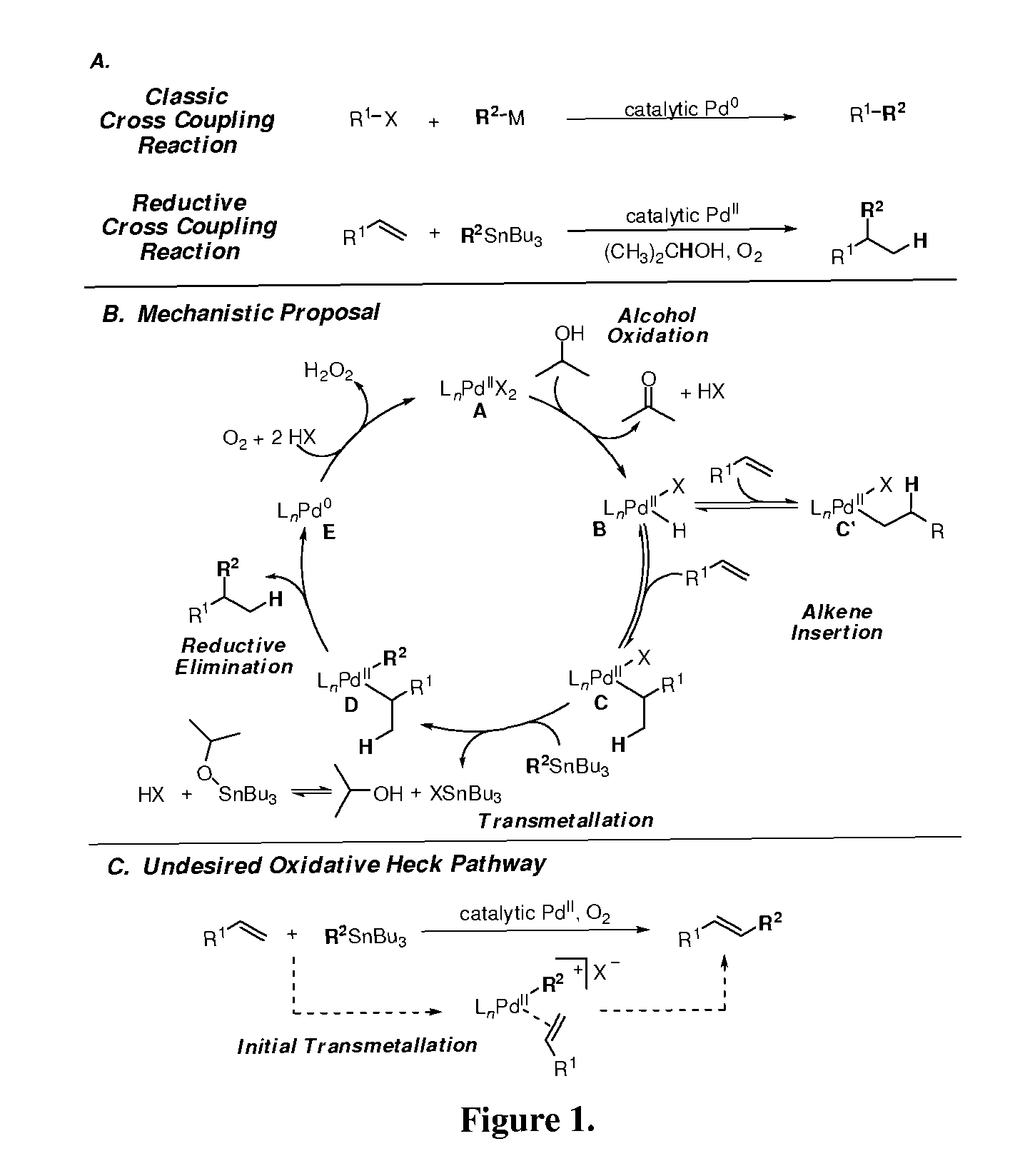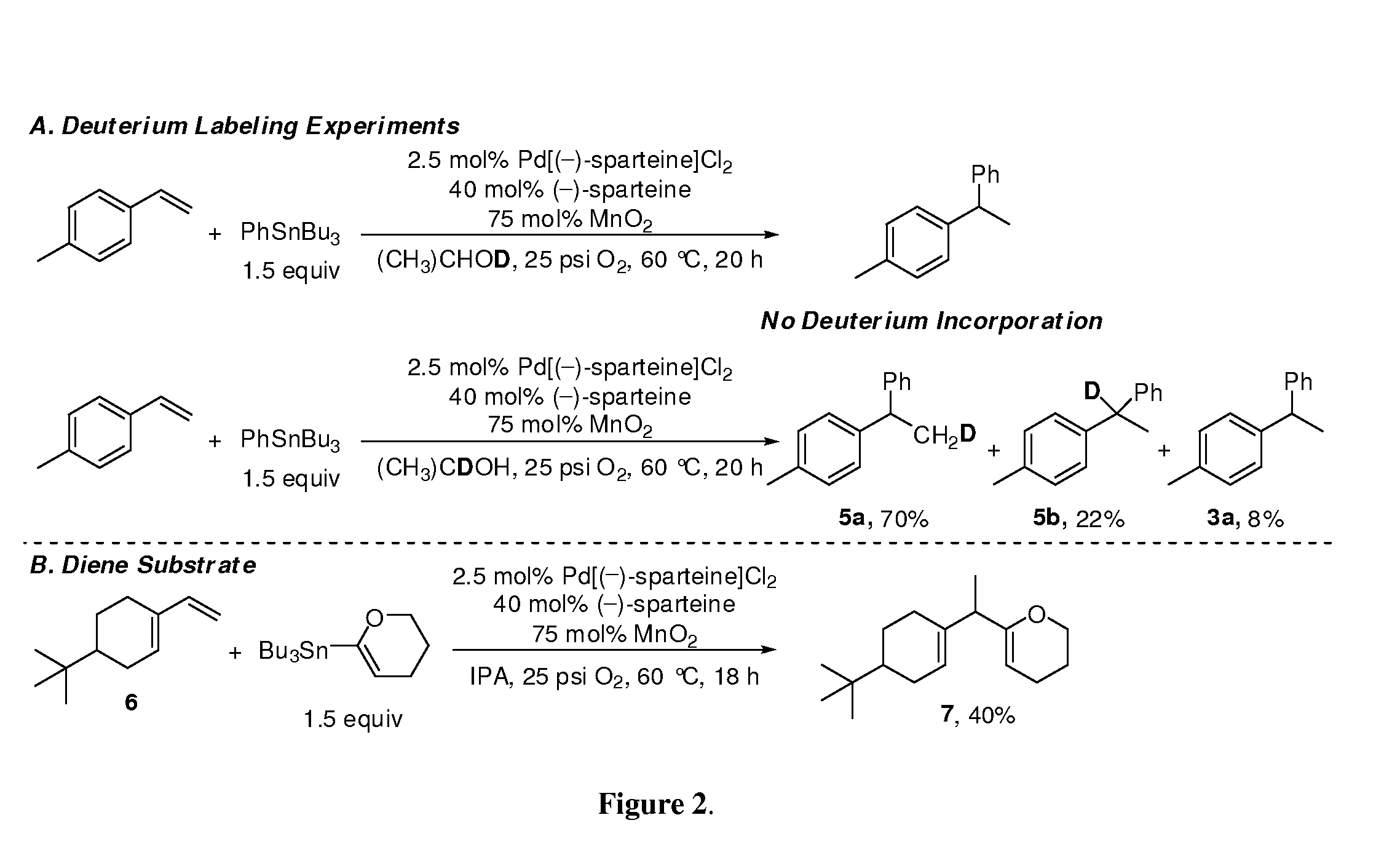Alkene hydrofunctionalization reactions
a technology of hydrofunctionalization and alkene, which is applied in the field of chemical synthesis, can solve the problems of limiting the potential scope of these ubiquitous transformations, and achieve the effect of enhancing the versatility of pd-catalyzed cross coupling reactions
- Summary
- Abstract
- Description
- Claims
- Application Information
AI Technical Summary
Benefits of technology
Problems solved by technology
Method used
Image
Examples
example 1
Hydroarylation Using a Reductive Cross Coupling Reaction Process for Functionalization of a Nucleophilic Alkene
[0045]Careful selection of the catalyst and solvent can facilitate alcohol oxidation and avoid secondary reactions of the solvent with the olefin. Therefore, Pd[(−)-sparteine]Cl2, which has previously shown to be a robust catalyst for both olefin and alcohol oxidations, was selected as a particularly suitable catalyst. An inexpensive solvent, 2-propanol, was chosen since secondary alcohols are good substrates for alcohol oxidation and are less likely to undergo Pd-catalyzed reactions with olefins directly. A styrene (alkene) substrate was initially evaluated due to the inability of the alkene to isomerize and PhSnBu3 was used as the initial cross-coupling partner because additives are not required to facilitate transmetallation of organostannanes.
[0046]
TABLE 1Optimization of reaction conditions for reductive coupling product 3a.EntryScaleaXYO2Temp.% Conv.b% 3ac3a:4d 1e0.200...
example 2
Mechanistic Examination
[0051]To the initial mechanistic hypothesis provided in FIG. 1B, two isotopic labeling experiments were performed to determine the origin of the proton incorporated into the product (FIG. 2A). When using (CH3)2CHOD as the solvent, no deuterium was incorporated into the product ruling out the involvement of acidic protons in the process. However, when using (CH3)2CDOH as solvent, 92% of the products contained a single deuterium atom as a mixture of isotopomers 5a and 5b. These data support the mechanistic hypothesis that a coupled alcohol oxidation to form a Pd-hydride is followed by insertion of the olefin into the Pd-hydride (FIG. 1B). The production of two isotopomers supports the reversible formation of both intermediates C and C′ from B but the observation of a single product regioisomer suggests only C leads to product. A possible explanation for this is that intermediate C can be stabilized by forming a π-benzyl species when using a styrenyl substrate. A...
example 3
Extension to Asymmetric Catalysis
[0053]The present invention uses organometallic reagents coupled with an alcohol oxidation to provide entry into a regioselective hydroarylation reaction of olefins. Additionally, considering the substantial number of organostannane and boronic acid derivatives readily accessible, successful method development will allow access to diverse, potentially biologically relevant structures, which would be difficult to prepare rapidly otherwise.
[0054]Extension to Asymmetric Catalysis.
[0055]Based on initial results and the mechanistic hypothesis, asymmetric catalysis can be achieved in accordance with the present invention. There are no reported intermolecular enantioselective hydroarylation reactions of simple olefins with the exception of norbornene. Therefore, the development of asymmetric variants will allow rapid entry into enantiomerically enriched products that are otherwise difficult to access. Two steps can particularly influence asymmetric inductio...
PUM
| Property | Measurement | Unit |
|---|---|---|
| temperature | aaaaa | aaaaa |
| time course analysis | aaaaa | aaaaa |
| time course analysis | aaaaa | aaaaa |
Abstract
Description
Claims
Application Information
 Login to View More
Login to View More - R&D
- Intellectual Property
- Life Sciences
- Materials
- Tech Scout
- Unparalleled Data Quality
- Higher Quality Content
- 60% Fewer Hallucinations
Browse by: Latest US Patents, China's latest patents, Technical Efficacy Thesaurus, Application Domain, Technology Topic, Popular Technical Reports.
© 2025 PatSnap. All rights reserved.Legal|Privacy policy|Modern Slavery Act Transparency Statement|Sitemap|About US| Contact US: help@patsnap.com



